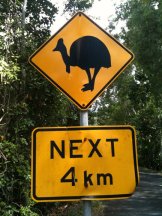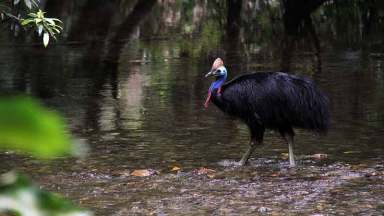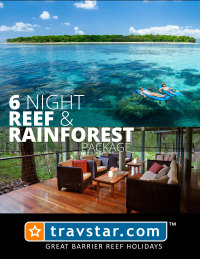BE CASS-O-WARY
Cassowaries are an endangered species found throughout the rainforests, and nearby woodlands and swamps of North Queensland. These large flightless birds play an important role in the dispersal of rainforest plant seeds.
Cassowary populations face a variety of threats. As habitat disappears, human contact with cassowaries is increasing. Cassowary behaviour is unpredictable. Cassowaries are known to kick with their large clawed feet. This can be dangerous for people and pets.
Cassowaries are potentially dangerous. Avoid unnecessary risks and help protect cassowaries by following these guidelines in cassowary territory.
- Never approach cassowaries
- Never approach chicks - male cassowaries will defend them.
- Never feed cassowaries - it is illegal, dangerous and has caused cassowary deaths.
- Always discard food scraps in closed bins.
- Always slow down when driving in cassowary territory.
- Never stop your vehicle on the road to look at cassowaries.
- Keep dogs behind fences or on a leash.
- Report cassowary sightings and incidents to your local Queensland Parks and Wildlife Service Office.
GETTING TO THE DAINTREE
Air:
Domestic and International visitors can fly direct to Cairns, where a number of transfer options to Cape Tribulation are available. An airstrip in Cow Bay provides access for planes and helicopters. Of course, the primary reason for taking this method of travel is so you can get a birds eye view of the pristine rainforest.
Self Drive:
Public transport is limited throughout the Daintree region, so we highly recommend hiring a vehicle and self driving. The majority of attractions and activities are well spread out between the Daintree River and Cape Trib Beach, which is an hour’s drive. There are many dining opportunities also in the Daintree, so hiring a vehicle will provide a greater flexibility so you can get the most from your stay.
The Daintree Ferry provides access into the Cape Tribulation area. This is accessible by conventional vehicles except during periods of heavy rain. The road is sealed as far as Cape Tribulation. Crossing the Daintree River via a vehicular ferry is an experience not to be missed. This ferry operates from 6am to midnight each day.
Vehicle users can be assured that a 4WD is not required to drive through the Daintree Rainforest, however the Bloomfield Track which begins at the northern side of the rainforest, is suitable only for 4WDs.
Limited fuel access is available, so it is best to fuel up beforehand.
It is a two-hour drive (approx.120 km) north of Cairns to the heart of the Daintree World Heritage area. Drive north out of Cairns along the Bruce Highway (Hwy 1). Continue on past the Port Douglas turnoff to Mossman (1 hr 30 mins). From Mossman continue north on the main highway past Wonga Beach (15 minutes from Mossman) and 10 km later turn right to reach the Daintree River ferry. From here it is a 1 hour journey to Cape Tribulation beach.
Drive Guidelines
Please drive safely and carefully while in the area. If you wish to stop, pull over and park safely, not on the road. Sometimes it is safer to walk back to the attraction.
It is safe to drive at night, providing you obey the speed limits and keep a sharp lookout for wildlife. Wildlife is usually only killed by speeding drivers.
Please respect private property while in the area.
During heavy rain, water does run over the road. Please be careful and check the depth before crossing. The water usually recedes quite quickly once the rain has stopped.
Coach Transfers:
Coach transfers are available between Cairns and Cape Tribulation daily. We recommend Sunpalm Transport who operate scheduled coach and bus transfer services between Cairns, Port Douglas, Daintree, Cape Tribulation and Cooktown as well as an airport shuttle service from Cairns Airport to most resorts.
Transfer time is approximately two and half to three hours from Cairns. Transfers from Cairns depart daily at 7:00am and 10:30am only.
Cape Trib Connections offers a similar service daily, but combines budget overnight accommodation with a guided tour in the package. You can choose a 1, 2 or 3 night stay at the accommodation of your choice.
You will journey from Cairns to the Daintree Mangroves Animal Sanctuary followed by the Mardja Boardwalk, before being dropped off at your accommodation. The journey is fully guided and you will be collected from your accommodation at a similar time on your departure day. This option is ideal for single travelers or those on a budget.
MARINE STINGERS
We often receive phone calls from concerned travellers regarding the Jellyfish.
Most jellyfish are harmless to man, however certain varieties may cause a serious reaction. Incidents involving serious marine stings in this area are becoming more common during the Stinger Season. It is important to follow the below precautions to avoid being stung.
At certain times of the year, jellyfish, commonly called marine stingers, can affect the coastal waters of North Queensland. These stingers are easily avoided provided correct precaution is taken.
Most local people choose not to swim in our local beaches during the stinger season. All hotels and resorts have a swimming pool in North Queensland so there is no need to worry about where you can cool down. We also have a wealth of beautiful rainforest waterfalls in the region and the water is very cool and refreshing.
Visitors wishing to swim at beaches between November to May/June will need to take precautions.
Precautions: In order to prevent getting stung by marine stingers take the following precautions to ensure your day at the beach is enjoyable.
- During this period you must only swim in protective swimming enclosures
- Always swim at patrolled beaches between the red and yellow flags
- Only swim in stinger nets if they are provided. They offer a high degree of protection.
- Stinger nets are not stinger "proof) Check with the lifegaurd.
- Do not sit on the stinger nets.
- Wear protective clothing (stinger suit)
- Slowly enter the water - marine stingers will move away given the time and opportunity
- Do not touch marine stingers washed up on the beach, they can still sting
- Always make sure you have mobile coverage
Jellyfish on the Reef:
If you are concerned we recommend wearing a stinger suit even when you are swimming at the reef. Not only do stinger suits protect you from the sun at this very sunny time of the year, but, you will also save yourself the worry of being stung.
Lycra suits and wet suits are available on all reef trips to protect guests from the sun and to reduce the possibility of stings & irritations.
Jellyfish at the reef are dependant on the weather conditions and all reef operators will take appropriate steps to ensure your protection if they believe conditions are such that there is a possibility of encountering these creatures.
Box Jellyfish (Chironex fleckeri):
The box jellyfish is found along the coastline during the summer months (November to May/June).
The predominat recorded stings from the Box Jellyfish are along coastal areas. (ie; beaches) The box jellyfish is a coastal species and is not found out on the reef, but they can sometimes be found around islands close to the mainland.
Chironex are large (almost transparent) jellyfish with a "box-shaped" bell (with 4 corners) up to 30cm in diameter. They can have up to 15 "ribbon like "tentacles from each corner and tentacles can be up to 3 metres in length. Early in the season the jellyfish are quite small but they grow quite large as the season goes on.
Irukandji:
Irukandji can be found coastally on reefs and islands and at times close to shore.
They are very small. Usually described as being the size of a finger nail, however they can grow up to 10cm in diameter. They are transparent and also have a "box shaped" bell (with 4 corners). They only have a total of 4 thin tentacles. stingers that are sometimes encountered on the reef include the irukandji.
FIRST AID:
- CALL FOR HELP - Dial 000 for an Ambulance
- Emergency care - Administer CPR if needed - Oxygen should be applied for Irukandji stings
- Treat the sting - Pour vinegar onto sting.
- Seek medical aid - Transport to hospital.
Both can cause a nasty sting, Vinegar can used on both box jellyfish and irukandji stings but not on blue bottle stings. For blue bottles use cold water and ice.
For more comprehensive information please visit the Queensland governement health, Surf Life Saving Australia or Surf Life Saving Queensland websites. These sites all come up when you search for information on Marine Stingers on google.
LOCATION
'The Daintree' is a loose term for the coastal lowland area between the Daintree and Bloomfield Rivers, also known as the Daintree Coast. There is also the Daintree National Park (stretching from Mossman Gorge to Bloomfield River) and Daintree Village, about 12 km upstream from the ferry crossing.
The Daintree Rainforest is situated an easy 2 hour drive north of Cairns along one of the most beautiful coastal roads in the world.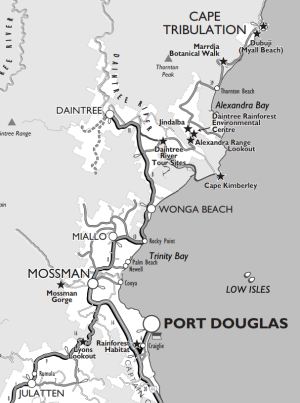
Cairns to Port Douglas is 60km, around a 1 hour drive. Mossman is 15km north of Port Douglas and Mossman River to Daintree Village is a picturesque 35 km, half-hour drive.
Daintree Village is perched on a bend of the Daintree River, and is just further on from the turn off to the Daintree Ferry.
This historic little township is a must see, located on the southern bank of the majestic Daintree River and the perfect setting for relaxing bit to eat and a cool refreshing drink.
Heading “over the river”, the distance from Cairns to Cape Tribulation Beach is 140km, approximately two-and-a-half hours' drive. Cape Tribulation Beach is located 36km north of the Daintree ferry crossing.
The Daintree River Ferry Crossing is open from 6am to midnight daily, and is the start of a spectacular 36km drive through the rainforest, ranges and coastal communities along Cape Tribulation Road.
The road to Cape Tribulation is now fully sealed.
SELF DRIVE
The Cook Highway north of Cairns offers beautiful scenery ranging from secluded palm fringed tropical beaches, hidden coves and rugged headlands to the rich green of lush sugar-cane fields and rainforest covered mountains. This spectacular one and a half hour drive to Daintree Village takes you through the coastal villages of Ellis Beach and Wangetti to Rex Lookout, for a sweeping view south along the coast to Cairns that simply must be photographed.
It is around a thirty-minute drive north of Port Douglas to Mossman, a pleasant little town set amongst the lush cane fields. Mossman Gorge is a must stop for all trips heading up to the Daintree and Cape Tribulation. The highway leaves the coast at Wonga Beach for a 15-kilometre drive through the forests of the Dagmar Ranges, and then into Daintree Village.
Public transport is limited throughout the Daintree region, so visitors not having their own transport should consider hiring a vehicle from one of the many car-hire companies in Cairns or Port Douglas.
The Daintree Ferry provides access into the Cape Tribulation area. This is accessible by conventional vehicles except during periods of heavy rain. The road is sealed as far as Cape Tribulation. Crossing the Daintree River via a vehicular ferry is an experience not to be missed. This ferry operates from 6am to midnight each day.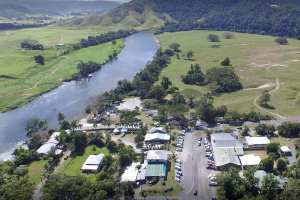
After crossing the Daintree Ferry you travel through lowland and tropical rainforest passing road junctions for Cape Kimberley and Cow Bay.
There are some excellent coastal views and several tourist attractions. The road runs over several high capes and alongside attractive beaches. Camping spots and accommodation are available. A small general store is located at Cow Bay. Limited fuel access is available.
Vehicle users can be assured that a 4WD is not required to drive through the Daintree Rainforest, however the Bloomfield Track which begins at the northern side of the rainforest, is suitable only for 4WDs.
The Bloomfield Track links Cape Tribulation and The Bloomfield River. It is a true 4WD Track as there is very little gravel on parts of the surface, unimproved creek crossings, steep climbs and decents, lots of mud and plenty of opportunity to get stuck if it is wet. The actual condition of the road varies enormously, and it can be anything from an easy drive, to almost or completely impassable.
Drive Guidelines:
Please drive safely and carefully while in the area. If you wish to stop, pull over and park safely, not on the road. Sometimes it is safer to walk back to the attraction.
It is safe to drive at night, providing you obey the speed limits and keep a sharp lookout for wildlife. Wildlife is usually only killed by speeding drivers. Please respect private property while in the area.
During heavy rain, water does run over the road. Please be careful and check the depth before crossing. The water usually recedes quite quickly once the rain has stopped.
WHAT TO PACK
Keep in mind when packing that it may cost you at check in if you're too heavy. And, leave some space just in case you find some great little purchases on your travels.
Pack your clothes flat with fewer folds. Lay pants and dresses flat on the bottom, add clothes and shoes (in bags ), then fold the rest of the garments over (like a pita bread). If you don't want crushes for a special dress use tissue paper between. Then compress.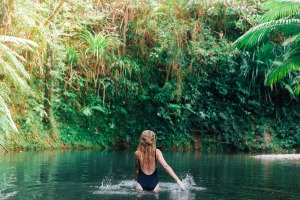
Year round we wear t.shirts and shorts during the day. In the evenings in July and August you could wear a sweater or cardigan and trousers. But, during the day even at these times it is still possible to swim in the ocean with water temperature at around 24 degrees. In the summer months wear as little as possible.
Leave the strappy heels behind. Ok, you can bring just one pair! But, in North Queensland it is not as necessary to wear heels or suits unless you're coming for a special occasion. We love to dress up when the time is right but it is very relaxed up here. For your tropical holiday pack sandals, fully enclosed shoes for hiking, river walker sandles that can get wet if you're white water rafting and flip flops/thongs for the beach. Comfy shoes like ballet flats with enforced soles are also handy.
There are new little packages of toiletries for travelling that are very handy and negate the need to carry all of the bottles. Remember your SPF
30, mosituriser, paw paw lotion and mozzie spray just in case.
I don't think you need a blow-dryer as most hotels have them in the room. It's like summer year round up here. It's humid, and you're going to frizz within fifteen minutes anyway. A ponytail and headband and a hat work well with heat and humidity.
See you in TNQ!




